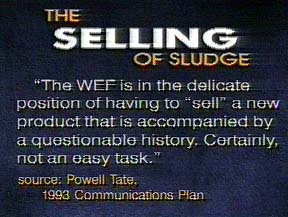|
EPA defends sludge rules
|
 |
June 27, 1997: 8:14 p.m. ET
Moneyline Special Report: Selling sludge is a sticky operation
From Correspondent Bill Dorman
|
WASHINGTON (CNNfn) - As opposition to the federal policy of recycling sewage sludge as farm fertilizer grows, the story the selling of recycled sludge of who's not buying continues.
Sewage sludge. It's waste from households and industries treated at a sewage plant and soon to be recycled as fertilizer. The Environmental Protection Agency prefers you call it "biosolids."
So does the Water Environment Federation, the industry group for sewage plants across the country.
"What it should convey is that this is a material that is carefully processed and tightly regulated, carefully monitored and fully controlled. precisely for the purpose of protecting public health," said Albert Gray, deputy executive director of the Water Environment Federation.
But selling the concept of sludge as a fertilizer has been difficult despite a high-powered lobbying effort.
Powell Tate, the Washington public relations firm that advises sludge producers, conceded as much in a 1993 memo.

The largest of America's food producers remain unconvinced.
You won't find any tomatoes fertilized with sludge in a bottle of Heinz ketchup. Heinz guarantees that none of its products are grown with sludge.
Heinz tells CNNfn it is "adamant" in its policy and "aggressive" in enforcing it." Del Monte has a similar policy. The National Food Processors' Association says it "does not endorse the use of sewage sludge on crop land" in part because "state and federal oversight may not be sufficient."
The Water Environment Federation insists science is on its side, citing studies by the National Academy of Sciences and other reports that say biosolids are safe for food crops.
"There is a very strong consensus in the scientific community about the safe levels of biosolids when applied to food crops," Gray said.
The United States Fifth Circuit Court of Appeals says otherwise.
In a case early in June, the court said "experts have yet to reach a consensus on the safety of land application of sludge."
And there is other evidence.
Take cadmium, a heavy metal, and the lack of global consensus on safe levels.

Denmark limits cadmium in sludge fertilizer to less than one part per million. Germany allows 10 parts per million. The state of New York allows 25. The EPA -- even in what it calls "exceptional quality sludge" -- allows 39 per million.
The EPA policy faces strong criticism even within the agency.
"Official U.S. government policy in the Clinton administration is to grow food chain crops --the food supply of America -- on poison. And not to tell the public," EPA engineer Hugh Kaufman says.
The EPA denied a request by a New Hampshire citizens group, which asked for special labels on food fertilized with sludge.
"For one thing, biosolids -- sewage sludge --are in a lot of different fertilizers -- used as filler in fertilizers," said Dana Minerva of the EPA's water office. "So you'd almost have to label every single jar and can."
That would be just fine with Helane Shields of Alton, N.H.
"The only way we can fight back and stop this assault on our environment is by enacting ordinances on a town-by-town basis," Shields said.
But in almost every city and town, it's economic, rather than environmental, concerns that are driving this debate. Sludge recycling saves money for thousands of sewage plants. and that economic reality has shaped a policy that up to now has also been marked by a lack of public awareness. 
|
|
|
|
|
 |

|

